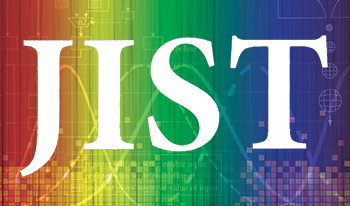
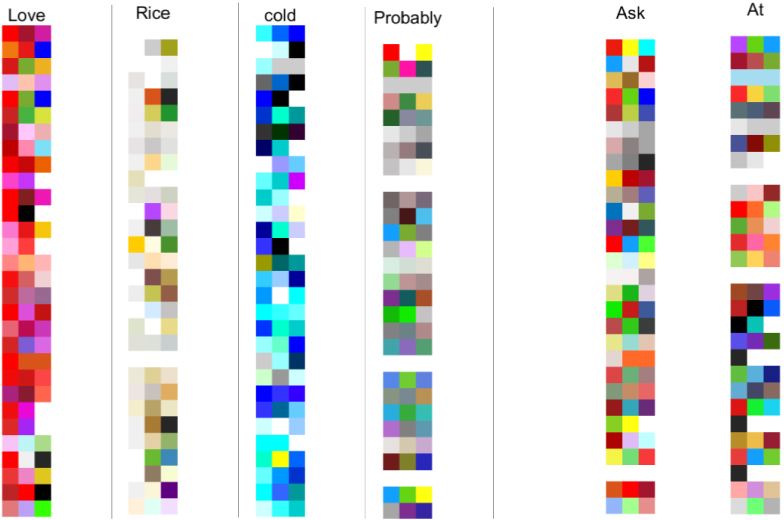
This study mainly focused on exploring the associations between words and colours. Colour association expresses a specific relationship between colour and various concepts or objects. However, it is noticed that when colour association is discussed, it is often in one direction; from colours to concepts. In this study, it is posited that colour association is bidirectional, meaning that we can also start with a word or concept and answer the question which colour or colours are associated with it. A psychophysical experiment was carried out to collect specific colour associations from target words. In the results, the strong similarity of the associated colours for each word was presented, meaning that people selected similar colours for each word. The study also indicated that different word classes have different degrees of association with colours. This study elucidates strong associations from words to colours, an important contribution of this work is to emphasise the direction word– >colour in terms of colour association.
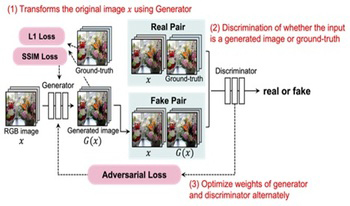
Color-space conversion technology is important to output accurate colors on different devices. In particular, CMYK (Cyan, Magenta, Yellow and Key plate) used by printers has a limited range of representable colors compared with RGB (Red, Green and Blue) used for normal images. This leads to the problem of loss of color information when printing. When an RGB image captured by a camera is printed as is, colors outside the CMYK gamut are degraded, and colors that differ significantly from the actual image may be output. Therefore, printers and other companies manually correct color tones before printing. This process is based on empirical know-how and human sensitivity and has not yet been automated by machines. Therefore, this study aims to automate color correction in color-space conversion from RGB to CMYK. Specifically, we use machine learning, utilising a large color-conversion database owned by printing companies, which has been cultivated through past correction work, to learn the color-correction techniques of skilled workers. This reduces the burden on the part of the work that has been done manually, and leads to increased efficiency. In addition, the machine can compensate for some of the empirical know-how, which is expected to simplify the transfer of skills. Quantitative and qualitative evaluation results show the effectiveness of the proposed method for automatic color correction.
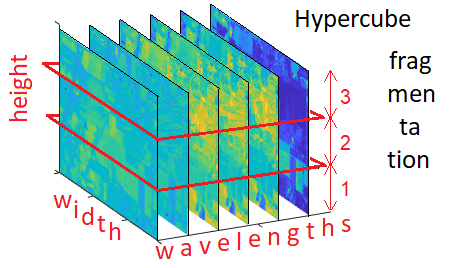
In this article, we present a method for processing hyperspectral data in an easy and quick manner. We explain how we split the hyperspectral cube in different sections to be processed using fewer resources. We describe the processing, which includes extraction of the raw data along with white and black calibration data, calibration of the data and application of desired light source, color space, and gamma transformation. We then present a built-in software, including an easy interactive Graphical User Interface (GUI) that will allow fellow researchers to process hyperspectral images in a simple fashion.

Algorithms for computational color constancy are usually compared in terms of the angular error between ground truth and estimated illuminant. Despite its wide adoption, there exists no well-defined consensus on acceptability and/or noticeability thresholds in angular errors. One of the main reasons for this lack of consensus is that angular error weighs all hues equally by performing the comparison in a non-perceptual color space, whereas the sensitivity of the human visual system is known to vary depending on the chromaticity. We therefore propose a visualization strategy that presents simultaneously the angular error (preserved due to its wide adoption in the field), and a perceptual error (to convey information about its actual perceived impact). This is achieved by exploiting the angle-retaining chromaticity diagram, which shows errors in chromaticities while encoding RGB angular distances as 2D Euclidean distances, and by embedding contour lines of perceptual color differences at standard predefined thresholds. Example applications are shown for different color constancy methods on two imaging devices.
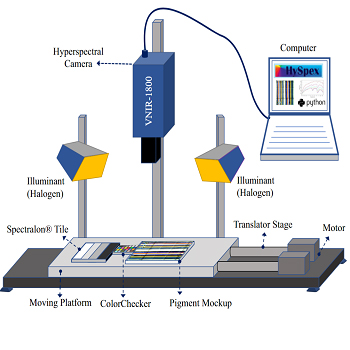
Cultural heritage objects, such as paintings, provide valuable insights into the history and culture of human societies. Preserving these objects is of utmost importance, and developing new technologies for their analysis and conservation is crucial. Hyperspectral imaging is a technology with a wide range of applications in cultural heritage, including documentation, material identification, visualization and pigment classification. Pigment classification is crucial for conservators and curators in preserving works of art and acquiring valuable insights into the historical and cultural contexts associated with their origin. Various supervised algorithms, including machine learning, are used to classify pigments based on their spectral signatures. Since many artists employ impasto techniques in their artworks that produce a relief on the surface, i.e., transforming it from a flat object to a 2.5D or 3D, this further makes the classification task difficult. To our knowledge, no previous research has been conducted on pigment classification using hyperspectral imaging concerning an elevated surface. Therefore, this study compares different spectral classification techniques that employ deterministic and stochastic methods, their hybrid combinations, and machine learning models for an elevated mockup to determine whether such topographical variation affects classification accuracy. In cultural heritage, the lack of adequate data is also a significant challenge for using machine learning, particularly in domains where data collection is expensive, time-consuming, or impractical. Data augmentation can help mitigate this challenge by generating new samples similar to the original. We also analyzed the impact of data augmentation techniques on the effectiveness of machine learning models for cultural heritage applications.
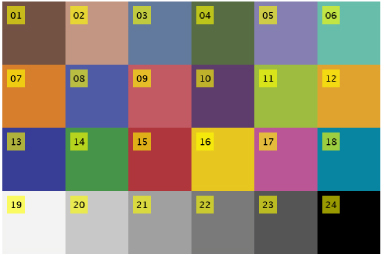
Color performance is an important safety and performance attribute of endoscopes. An endoscope that exhibits poor color performance inadequately reproduces color images and may make it difficult for the endoscopist to visualize features needed for diagnostic or therapeutic tasks. Various color performance testing methods have been developed to evaluate color fidelity of endoscopes since 1987. However, these testing methods have limited utility because most endoscopes cannot and do not intend to reproduce the original color faithfully. In this work, endoscope color performance is reviewed by evaluating preservation of color contrast between patches and preservation of the patch order in lightness, hue, and chroma. The analysis method was implemented as the Color Performance Review (CPR) tool and is available in the catalog of Regulatory Science Tools published by FDA/CDRH/OSEL.
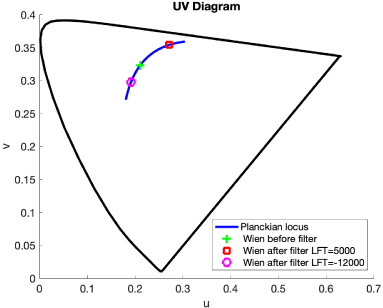
Recently, a theoretical framework was presented for designing colored filters called Locus Filters. Locus filters are designed so that any Wien-Planckian light, post filtering, is mapped to another Wien-Planckian light. Moreover, it was also shown that only filters designed according to the locus filter framework have this locus-to-locus mapping property. In this paper, we investigate how locus filters work in the real world. We make two main contributions. First, for daylights, we introduce a new daylight locus with respect to which a locus filter always maps a daylight to another daylight (and their correlated color temperature maps in analogy to the Wien-Planckian temperatures). Importantly, we show that our new locus is close to the standard daylight locus (but has a simpler and more elegant formalism). Secondly, we evaluate the extent to which some commercially available light balancing and color correction filters behave like locus filters.
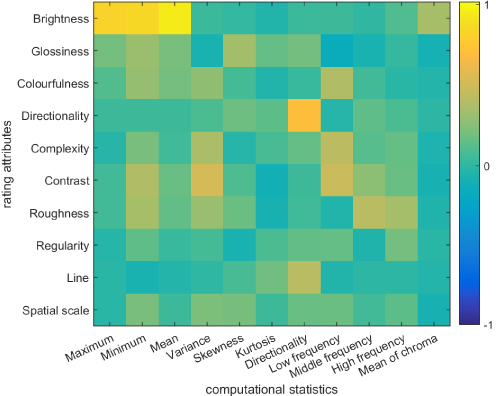
An efficient computational characterization of real-world materials is one of the challenges in image understanding. An automatic assessment of materials, with similar performance as human observer, usually relies on complicated image filtering derived from models of human perception. However, these models become too complicated when a real material is observed in the form of dynamic stimuli. This study tackles the challenge from the other side. First, we collected human ratings of the most common visual attributes for videos of wood samples and analyzed their relationship to selected image statistics. In our experiments on a set of sixty wood samples, we have found that such image statistics can perform surprisingly well in the discrimination of individual samples with reasonable correlation to human ratings. We have also shown that these statistics can be also effective in the discrimination of images of the same material taken under different illumination and viewing conditions.
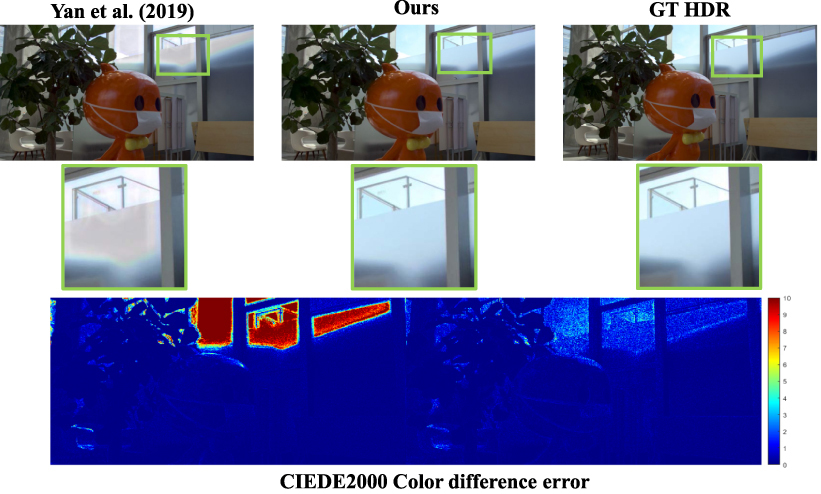
We propose a three stage learning-based approach for High Dynamic Range (HDR) video reconstruction with alternating exposures. The first stage performs alignment of neighboring frames to the reference frame by estimating the flows between them, the second stage is composed of multi-attention modules and a pyramid cascading deformable alignment module to refine aligned features, and the final stage merges and estimates the final HDR scene using a series of dilated selective kernel fusion residual dense blocks (DSKFRDBs) to fill the over-exposed regions with details. The proposed model variants give HDR-VDP-2 values on a dynamic dataset of 79.12, 78.49, and 78.89 respectively, compared to Chen et al. [“HDR video reconstruction: A coarse-to-fine network and a real-world benchmark dataset,” Proc. IEEE/CVF Int’l. Conf. on Computer Vision (IEEE, Piscataway, NJ, 2021), pp. 2502–2511] 79.09, Yan et al. [“Attention-guided network for ghost-free high dynamic range imaging,” Proc. IEEE/CVF Conf. on Computer Vision and Pattern Recognition (IEEE, Piscataway, NJ, 2019), pp. 1751–1760] 78.69, Kalantari et al. [“Patch-based high dynamic range video,” ACM Trans. Graph. 32 (2013) 202–1] 70.36, and Kalantari et al. [“Deep hdr video from sequences with alternating exposures,” Computer Graphics Forum (Wiley Online Library, 2019), Vol. 38, pp. 193–205] 77.91. We achieve better detail reproduction and alignment in over-exposed regions compared to state-of-the-art methods and with a smaller number of parameters.